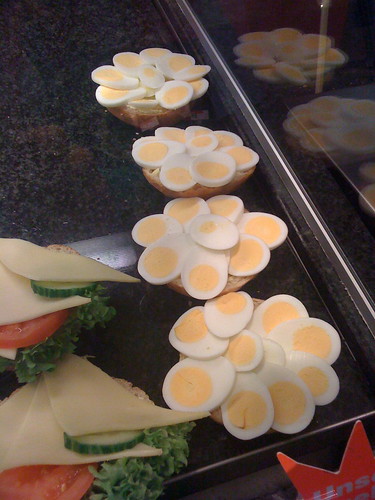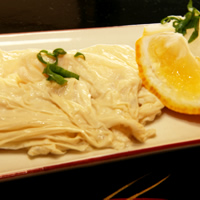
By now, many of us have heard of Harumi Kurihara: Japan's own 'naked-shufu' and multi-franchised answer to Jamie Oliver crossed with Martha Stewart. Got to give her kudos for her monthly magazine with its hundreds of stylish apron patterns and easy-to-make dishes like tofu with gorgonzola and pesto.
But in my opinion, the most reliable English language authority on Japanese cookery is
Hiroko Shimbo. This NYC-based author & consultant doesn't have her own line of crockery. She's pretty obscure compared to Harumi - I suppose she's unknown in Japan. But her book, The Japanese Kitchen, contains 250 well-curated recipes that would be an asset to any home. If you were going to have just one Japanese cookbook, this one would be it.
Erik & I have given this book a few years of heavy usage, and we still come across recipes we never noticed before: classics like quick salt-pickled cabbage with shiso & umeboshi, bamboo shoots tossed with sansho leaves, Senbei crackers, or wobbly black squares of sesame Goma-dofu. (Making senbei sounds like a challenge...I'm quite sure my results would be as bad as if I made a cake in a rice cooker. but Hiroko's never let me down, so maybe I'll give it a shot).
There're plenty of drawings demonstrating how to prepare sole (butterflied to fry and serve with ponzu sauce) or slice sashimi, and the book contains instructions for many varieties of comfort food, from spicy carrot&fennel itame, to fisherman's mackerel soup, eel burger or Nihon-style ratatouille (with miso). Hiroko even tells you how to make Satsuma-age fish cakes: very useful for all kinds of simmered dishes or cut up in stir fries (try them with kimchi, garlic chives, konnyaku slivers, sesame oil, sake, shoyu and pork mince). This book is truly indispensable, especially if you do not have ready access to packaged versions of favourites like the aforementioned Goma-dofu.
If you've ever been to Japan, y'all know what I'm talking about.
Today I'm posting Hiroko's pumpkin soup recipe. Pumpkin soup in its western incarnations is usually thick enough for a spoon to stand up in. Hiroko's bright orange kabocha-miso soup is different, swirling and delicate with nutmeg, chives, cinnamon and a dash of milk.
This soup takes me back to lunchtimes in Meguro, where we used to frequent a place called
News Café by the station that had checkered tablecloths and a big blackboard with chalked-on specials. We'd spoon up bright coloured liquids - tomato, pumpkin, corn - quickly from ladylike white soup tureens, while the secretary from our firm blinked a lot and hummed disbelieving noises at her food.
かぼちゃの味噌しる
11 ounces kabocha or butternut, seeded not peeled
One 4-inch square kelp soaked in 3 cups of water for an hour (or powdered kelp stock in 3 cups water)
One leek or naganegi, white part only, sliced
Cinnamon
Fresh ground nutmeg
2-3 tablespoons Saikyo miso (sweet white miso)
1/2 cup unflavoured soy (or cow) milk
1 tbsp minced chives
Have a bamboo or metal steamer with plenty of water at high steam production. Steam squash until soft, circa 20 min. With a soup spoon, discard any stringy bits or remaining seeds, then scoop out all the flesh and reserve.
In a medium pot, combine kombu stock and leek. Bring to a boil over medium heat, reduce to low and cook until soft.
Blend the pumpkin with leek & stock to a smooth puree.
Before serving, warm the soup base over medium heat. Add a little ground cinnamon and nutmeg. When heated through, add the miso and stir til it dissolves. Add the milk and heat without boiling (to avoid curdling).
Serve in bowls, garnished with chives.
(4 servings)

























